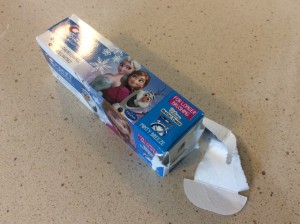Ever since I heard about Dr. Sherri Mason’s research on plastic microbeads in the Great Lakes, I’ve become very concerned, some say obsessed, with the issue of microbeads. The fixation began in my own house, where I found toothpastes, facial scrubs, and hand soaps with microbeads. My wife and I threw them all away, and vowed never to allow one of these products in our house again. Within almost no time at all, we failed. On a couple of occasions, microbeads deviously snuck their way into our home. We won a gift basket with liquid hand soaps that contained microbeads. I quickly noticed what it was and chucked it. After a dentist appointment for my daughters, the “goodie” bag they brought home had toothpaste with microbeads. An odd choice for a dentist, since the beads are being found lodged in gums and cavities, posing a potential threat for infection. Regardless, we threw them out, educated the dentist, and moved on.
The most recent invasion of microbeads into my home was today. My wife was at the store with my daughters shopping for a number of things, including toothpaste. They were out of the natural stuff that we usually buy and the kids think is gross, so our girls were excited to get something else this time. They quickly noticed a box of “Frozen” toothpaste. Put Anna and Elsa on anything, even something without sugar, and my kids will want to buy it. So it was a no-brainer; they had found what they wanted and threw it in the basket.
Not seeing a picture of sparkly toothpaste (aka toothpaste laden with plastic strictly for aesthetic purposes) on the box, my wife never noticed that the toothpaste had microbeads. When they arrived home, my four-year-old could not wait to brush her teeth. She walked over to me holding the box and was smiling from ear to ear. I took a quick look at the inert ingredients, and noticed what I had dreaded, polyethylene. Like the mean Dad that I am, I informed my daughter that this would pollute our lakes, and we could not use the toothpaste. As expected, it didn’t go well, and this is what the box looks like after we wrestled over it:
Aside from just sharing my personal failures and telling everyone I made my four-year-old cry today, I mention these stories for a reason. As someone that has worked on this issue for two years, doing countless hours of research, writing fact sheets, and advocating for policies to ban plastic microbeads, I consider myself somewhat educated on this issue. Yet, microbeads have made their way into my home. Being an educated consumer is extremely important, but it is not enough to solve the problem of plastic microbead pollution once and for all. For that, we need a legislative ban.
Legislation to ban plastic microbeads in personal care products passed the New York Assembly with near unanimous support in April. The same bill has been introduced in the Senate, and now has 37 cosponsors. Only 32 votes are needed for the bill to pass, making this a sure-thing if Senate leadership allows a vote. As of now, there are only a few days left before the end of the legislative session. Help us get this critical, no-brainer legislation over the finish line by emailing legislative leaders and demanding a vote before session comes to an end.

